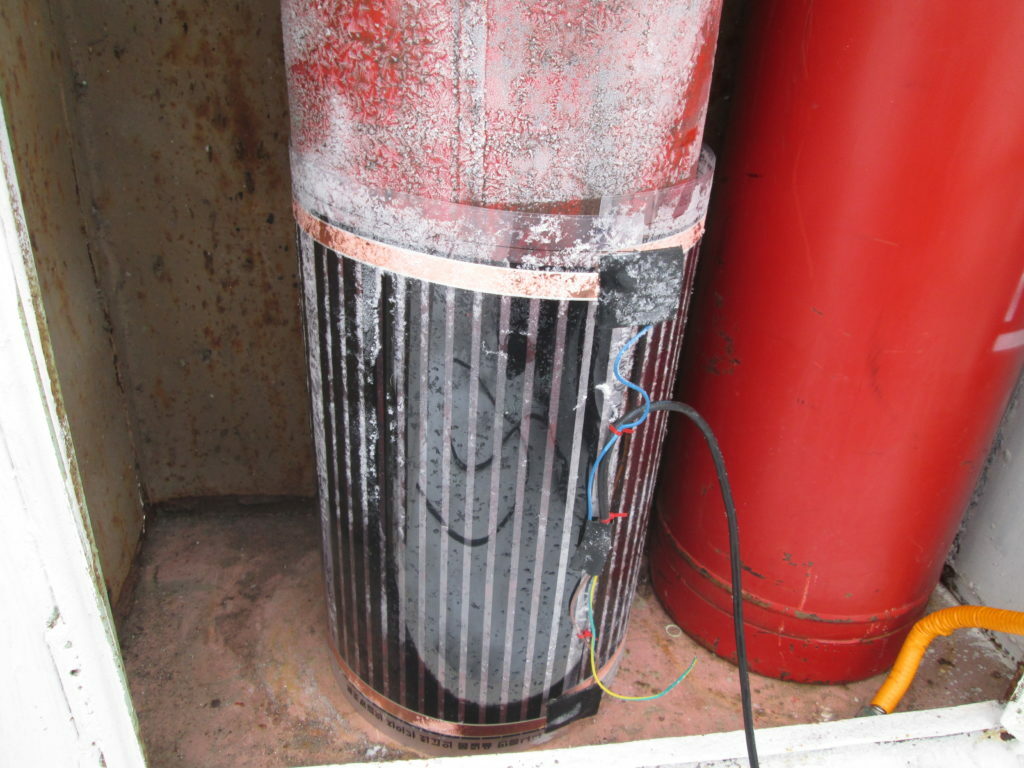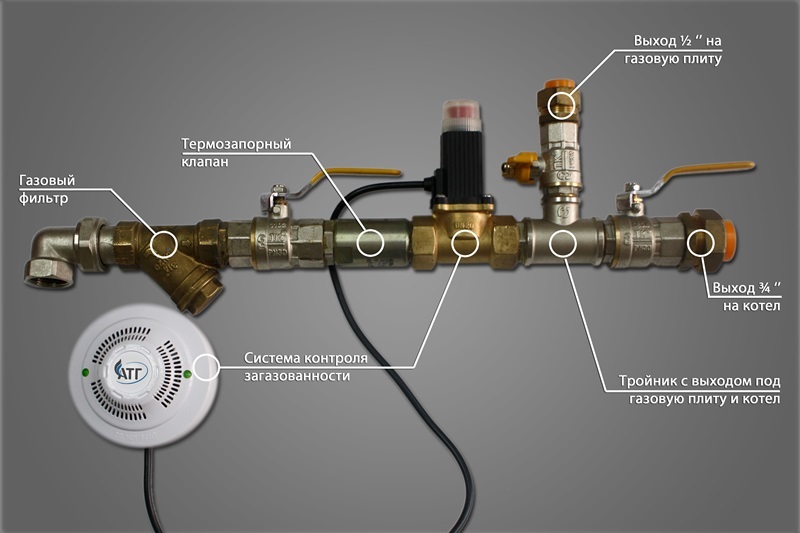The option of supplying gas in a cylinder is very relevant for owners of private houses and buildings, fishing trips and tourists, in a word, everywhere where there is no opportunity to connect to the central gas pipeline. And most users consider the gas cylinder to be a rather primitive device that will always work, because it has "nothing to break." Do you agree?
But you should be prepared for the fact that in the winter season, problems may unexpectedly overtake when propane is in vessels begins to freeze, and connected devices, including a stove or burner, simply stop function. The use of artificial heaters for gas cylinders violates safety standards, affects the conditions for fuel supply and impairs the heat exchange of the apparatus with the environment. The weak flame of the burner after such manipulations can simply disappear. But what should users do in such a situation, who cannot refuse to use bottled gas in any way?
We will help you deal with this issue - in the article we will talk about how the thermo blanket for gas cylinders is arranged and works, which is considered one of the safest heaters. Consider the technical characteristics, as well as the features of using such devices. We will also give basic recommendations for choosing a thermal blanket.
The content of the article:
-
The device and principle of operation of the thermal blanket
- When is additional cylinder heating needed?
- Characteristics and advantages of insulation
- Classification and equipment of the thermal blanket
- Recommendations for using the heater
- How to choose a thermal blanket?
- Conclusions and useful video on the topic:
The device and principle of operation of the thermal blanket
In a cylinder, gas is in a liquid state and under high pressure. Capacity fill up by about 80%. In the event of expansion of the fuel, caused for example by heating, an explosion will not occur.
First of all, during operation, the vapor phase of the gas is used, which rises upward. The liquid phase transforms into a vapor state as fuel is consumed. This process accompanies the consumption of the so-called fast molecules.
As a result of this process, the liquid loses energy and cools. The rate of decrease in temperature depends on evaporation as well as the presence of liquid in the cylinder. Gas supply will stop at a critical temperature mark. To prevent this from happening, users use special heating devices - thermo blankets. We will consider their features in more detail below.

It is forbidden to wrap gas cylinders in thermal insulation material. This type of insulation will stop heat exchange and only create the effect of a "thermos"
When is additional cylinder heating needed?
Blankets for household gas cylinders should be used at temperatures close to -15 degrees Celsius. When the mark of the thermometer reaches -30 degrees, the operation of the cylinder without a thermo blanket becomes impossible. This process is especially complicated in the winter season, since as the air temperature decreases, the freezing of the container accelerates.
Even in a room with an air temperature below zero, butane in the cylinder does not evaporate. From the combustion of propane, the boiler, convector and other gas-using devices go out. The remains of butane can be burned, but only at positive temperatures, or you will have to change the cylinder to a filled one.
On the surface of the vessel may also frost due to the poor quality of the fuel, especially if a non-special type of propane-butane is used at gas stations in the cold season. In such a mixture ("winter") propane should prevail, since it is this gas that evaporates even at sub-zero temperatures.
We examined in more detail the types and characteristics of gas mixtures in this article of ours: Types of gas mixtures in cylinders for a gas stove.

Insulation for a gas cylinder does not eliminate the need to use a sensor for continuous monitoring of the volume fraction of propane. The device is suitable for use in public, administrative, domestic and residential areas
The device provides heating of the gas cylinder to a safe level of +40 degrees Celsius. Under such conditions, complete evaporation of the mixture of propane and butane is achieved.
This principle of operation guarantees the stable operation of water heaters, convectors, boilers and stoves in the cold season, even at negative temperatures.
Characteristics and advantages of insulation
To heat the propane cylinder, you must use only safe devices, including a special thermo blanket.
Its main technical properties include the following:
- Heating is carried out up to a temperature of +40 degrees Celsius, the maximum deviation is +/- 5 ° C.
- The device is powered by a 220 network.
- Its power is 160 watts.
- At a temperature of -15 degrees Celsius, it consumes about 80 watts of electricity per hour.
- Unfolded size: 108 * 45 * 2, 116 * 103.2 cm.
- The thermo blanket weighs only 1 kg.
- Volume: 27, 40, 50 l, suitable for 33.5 l Ragasco cylinder.
- Helps save electricity up to 30%.
- Service life - at least 3 years.
- There is a power supply indicator.
The cost of purchasing a heater will pay off already in the first season, because the device allows you to save on the purchase of additional gas cylinders.
The uniform fuel consumption ensures the stability of the burners and stoves. The thermal blanket also normalizes the pressure inside the vessel and avoids dangerous situations due to the sharp temperature drop in winter.

Violation of the rules and technology of operation is one of the most common causes of gas cylinder explosions. But the usual temperature drop can also provoke a dangerous situation, for example, if the cylinder was at sub-zero temperatures without insulation, and then it was brought into a warm room
Has a thermo blanket and other advantages:
- does not lead to the formation of a dangerous condensate;
- suitable for use at any time of the year;
- convenient to use;
- provides complete evaporation of the liquefied fraction;
- robust construction;
- quick removal and reinstallation;
- custom production is possible - with certain dimensions and power;
- safety of work is ensured by an explosion-proof cable entrance;
- eliminates the need to use multiple heat sources at the same time.
Thermo blanket is suitable for heating cylinders and special cabinet. A galvanized protective structure must be used for storing cylinders with a volume of 12 liters or more.
Classification and equipment of the thermal blanket
Several types of heaters are produced:
- Categories "C", this type of thermal blanket is fireproof. The surface of the product is made of tarpaulin, the density of the material is 380 g / m2. Safety is provided by a fire-resistant mixture, which is used to treat the top of the blanket. Freeze-resistant cable and plug included.
- Categories "B" - moisture resistant type of thermal blanket. Its upper part is made of jacket fabric. As an inner layer, a heating nichrome wire with silicone insulation is used. A volumetric synthetic winterizer acts as thermal insulation - 300 g / m2.
For storage and transportation, there is a convenient case that comes with the kit.
After disconnecting the plug, it is necessary to remove the heater from the cylinder and place it in the protective cover.

A more complex design can also be used to heat a gas cylinder: a cabinet with gas insulation for its upper part, as well as a thermo blanket itself
The thermo blanket must also be disconnected from the mains while carrying. The cylinder should be stored in a place regulated by the Rules for the Construction and Safe Operation of Pressure Vessels PB 10-115-96approved by the Resolution of the Gosgortekhnadzor of the Russian Federation.
Recommendations for using the heater
We examined how it works and what a thermo blanket for a gas cylinder is. Now let's talk about how to use it correctly.
Before using a thermal blanket, you should check the tightness of the cylinder, as well as gas-using equipment. If violations of impermeability are detected, they should be eliminated. Disconnect the unit if external signs of a heater malfunction, including a defective power cable, are found.
We also recommend that you read the rules safe use of cylinders at home.
Depending on the need, the thermal blanket can be connected for the entire period of operation or used intermittently.
In working order, the heater is wrapped around the cylinder. The thermal blanket covers the entire surface of the container; Velcro is provided for fixing. A drawstring at the top provides access to the tap. To get started, just plug it into an outlet.

Gas cylinders must be at least one meter away from radiators and other heating devices. For heat sources with open fire, the distance is increased to 5 meters
The heater must not be used if there is a spark, smell of smoke, or damage to the insulation of the connecting cable. It is forbidden to use folded or wrinkled, as well as washing the product.
How to choose a thermal blanket?
Before buying, you should decide on type of cylinderto be warmed. It is important to consider the circumference, volume and dimensions.
As mentioned above, heaters are of special design - moisture-resistant and fire-resistant, they are distinguished from conventional models by additional functions.

When using multiple cylinders, the valves on the ramp should be left open. This will help ensure even fuel consumption between them.
The quality of a device can also be determined by several criteria:
- by heating time;
- if possible, maintain the desired temperature;
- for uniform heat distribution;
- the tightness of the blanket.
It should also be borne in mind that the cord should not protrude at the top of the end of the blanket, otherwise, it can lead to continuous bending of the cable and its further failure.
The blanket for heating a gas cylinder of standard sizes can also be used for plastic containers with a volume of 18 liters. This will allow you to save on ordering insulation in standard sizes.
But not only the thermal blanket will help to insulate the balloon. We have considered other safe ways in the next article.
Conclusions and useful video on the topic:
How to determine the type of heater for a gas cylinder and install them correctly, the following video plots will tell you.
Overview of Electric Vaporizer for Gas Cylinder:
Why gas freezes and how to avoid freezing of the cylinder:
How to make a heater with your own hands:
The thermal blanket saves about a third of the contents of the gas cylinder. Using the device eliminates the hassle of moving a heavy gas container into a heated room. Insulation maintenance does not require much effort. It is enough to use the case that comes with the kit. If used correctly, the device will last more than one year, but if any violations appear, you should definitely seek help from specialists.
Do you have any questions about the use of insulation, found inaccurate information on how the thermo blanket works, or want some advice? Leave your wishes, express your opinion, share your experience of use - the feedback form is located below the text.


